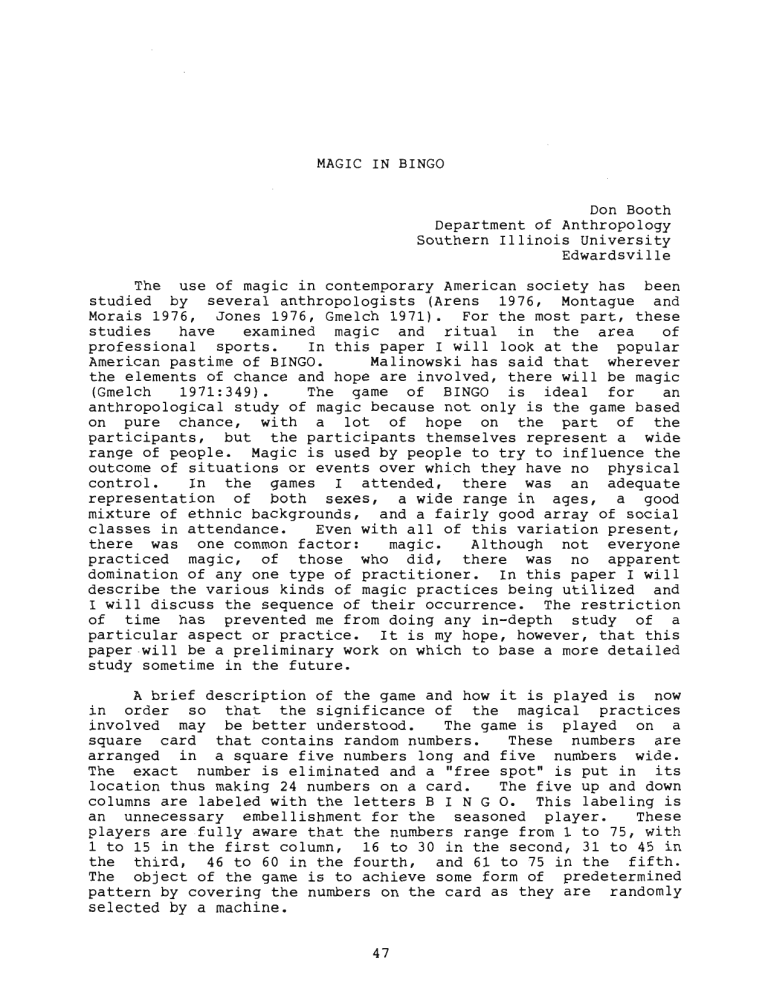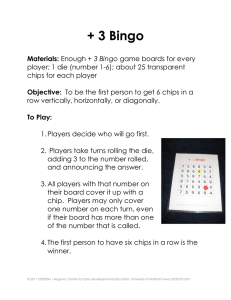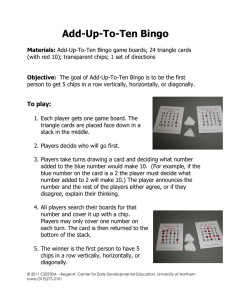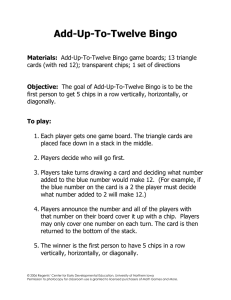MAGIC IN BINGO Don Booth Department of Anthropology Southern Illinois University
advertisement

MAGIC IN BINGO Don Booth Department of Anthropology Southern Illinois University Edwardsville The use of magic in contemporary American society has been studied by several anthropologists (Arens 1976, Montague and Morais 1976, Jones 1976, Gmelch 1971). For the most part, these studies have examined magic and ritual in the area of professional sports. In this paper I will look at the popular American pastime of BINGO. Malinowski has said that wherever the elements of chance and hope are involved, there will be magic (Gmelch 1971:349). The game of BINGO is ideal for an anthropological study of magic because not only is the game based on pure chance, with a lot of hope on the part of the participants, but the participants themselves represent a wide range of people. Magic is used by people to try to influence the outcome of situations or events over which they have no physical control. In the games I attended, there was an adequate representation of both sexes, a wide range in ages, a good mixture of ethnic backgrounds, and a fairly good array of social classes in attendance. Even with all of this variation present, there was one common factor: magic. Although not everyone practiced magic, of those who did, there was no apparent domination of anyone type of practitioner. In this paper I will describe the various kinds of magic practices being utilized and I will discuss the sequence of their occurrence. The restriction of time has prevented me from doing any in-depth study of a particular aspect or practice. It is my hope, however, that this paper-will be a preliminary work on which to base a more detailed study sometime in the future. A brief description of the game and how it is played is now in order so that the significance of the magical practices involved may be better understood. The game is played on a square card that contains random numbers. These numbers are arranged in a square five numbers long and five numbers wide. The exact number is eliminated and a "free spot" is put in its location thus making 24 numbers on a card. The five up and down columns are labeled with the letters BIN G o. This labeling is an unnecessary embellishment for the seasoned player. These players are fully aware that the numbers range from 1 to 75, with 1 to 15 in the first column, 16 to 30 in the second, 31 to 45 in the third, 46 to 60 in the fourth, and 61 to 75 in the fifth. The object of the game is to achieve some form of predetermined pattern by covering the numbers on the card as they are randomly selected by a machine. 47 Each of the sessions I attended consisted of 24 games. Of these games there are a number of variations on the pattern needed to achieve a win or BINGO. For example, there is regular BINGO, any straight horizontal, vertical, or diagonal line containing five numbers (of four numbers and the "free spot") or all four corners; Cover ALL BINGO, all 24 numbers covered on a card; Six Pack BINGO, two adjacent rows of three numbers originating in any corner; Letter X BINGO, two diagonal lines of four numbers and the "free spot", and so on. The first person to get the desired formation shouts "BINGO" and the game is halted while that player's card is checked for accuracy. If all of the numbers on the winning card have been called, the game is declared over and a new game is designated. Before looking at the magic aspect of BINGO, it will be necessary to clarify a few terms. The first of these is the "wait". A "wait" is the situation in which only one more number is needed to "BINGO". Another term is "tally card". The "tally card" is a small slip of paper you receive at the time you purchase your cards; it tells how many cards you receive at the time you purchase your cards; it tells how many cards you have purchased (therefore, how many cards you are allowed to play at one time). The "tally card" must be on display at your place at the table at all times. With this basic background, we can now examine an evening of BINGO magic. THE PRE-GAME SHOW The games that I attended began at seven o'clock in the evening but by five thirty, many participants were already arriving and engaging in their individual pre-game rituals. A major part of this behavior centers around seating. Some players feel that a particular seating location in the hall is "lucky" for them. Some are so determined to keep this seat from week to week that they arrive at the hall early in the afternoon, collapse the folding chair at their "lucky place" and lean it against the table as a sign to other participants that this spot is reserved. After reserving their seats, these players return home and await the evening's activities. I was informed that it is not proper BINGO etiquette to sit in someone else's reserved chair and that such action could result in a display of hostile aggression against the trespasser. Another important aspect of the pre-game ritual is the choosing of the cards. Regular BINGO players play an average of 12 to 15 cards si~ultaneously. After paying for their cards, receiving their "tally card", and finding a suitable place to sit, the players begin the long and arduous process of choosing their cards. The primary factor in selecting cards is not magical but numerical. The first objective of most of the players with whom I talked was that all of the numbers (1 to 75) 48 were present on their cards. The reasoning behind this objective is that the player would have at least one play for every number that was called in the course of the game (thus eliminating some of the boredom). Having filled this criterion on as few cards as possible, the player was now free to choose the remainder of his of her cards on a personalized basis. It was in this choice that what I call "special" and "significant" numbers came into play. "Special" numbers were any number that the player felt was lucky for him of her. These "special" numbers in some cases also had to be in a certain position on the card. For example, one player I observed always had at least one card with the number 66 in the lower right-hand corner; another player chose her primary cards so that the numbers 1 to 15 appeared in the upper left-hand corner of the fifteen cards being played. "Significant" numbers were documentary in nature; i.e. birth dates, anniversary dates, social security numbers, and so on (this method is also common in the selection of numbers for lottery tickets). With the process of card selection complete, the players now set up their individual playing paraphernalia. The sheer quantity of this equipment requires that the player carry some form of container. "Bingo Boxes" and "Bingo Bags" were the most common forms observed, although any container may be utilized. Bingo boxes and bags, however, are highly specialized and serve only one function, namely to carry BINGO equipment. The list of BINGO paraphernalia is surprisingly long. For example, any given Magnetic BINGO Chips - 300 of more Pennies - used to cover the "free spot" (non-magnetic) Ink Daubers - Used on disposable paper cards Glue - Used to glue paper cards together for ease of play Handled Magnet - For quick pick-up of magnetic chips Wait Markers - Plastic magnifying spotting "waits" markers for ease Clip or Stand - Used to display "tally card" Fetishes - Numerous and varied The fact that the fetishes, used only for BINGO and not removed for any other reason, are kept in the specialized containers gives the "Bingo Boxes" a slight resemblance to the "medicine bags" of the American Indians. used Of all of the paraphernalia utilized, the most obvious items in magic are the fetishes. I would now like to take a 49 in closer look at the kinds of fetishes present and some of the game rituals associated with them. pre~ For this study I have classified the fetishes into four categories: (1) Traditional Good Luck Charms, (2) Mystical Fictional Characters, (3) Animals, and (4) Miscellaneous Fetishes. Traditional Good Luck Charms are objects which have, in this country, a fairly long history of being "lucky" objects. Some of the Traditional Good Luck Charms I was able to observe were: a rabbit's foot, a small horseshoe charm, a lucky penny charm, and buckeyes (horse chestnuts). Buckeyes were the most commonly occurring charm found throughout this study. Players with a large number of fetishes (more than five) almost invariably included one or two buckeyes in their collection. Other items which may be included in this category are dice, either in pairs or singly, and salt (in small vials). There was also one example of a small, green nylon shamrock with the words "Good Luck" printed on it which could be classified in this category. Although for the most part these "Traditional Good Luck Charms" were used in conjunction with other fetishes, I did observe one player with only this type of charm (rabbit's foot, small horseshoe, lucky penny charm, and a buckeye). The second category of "Mystical Fictional Characters" contained a wide range of objects of both old and new origins. This category included such items as: unicorns, elfs, trolls, "Smurfs", "Gumby" figurines, and "E.T." figures. It can be seen by this list that these objects have, by their fictional characterization, a magical nature. The most commonly occurring item in this category were the "Smurf" figurines. These small, blue cartoon characters were very popular. The fact that as fictional characters they possess magical powers may be the reason for their popularity. However, informants, when asked, denied this association (they also denied that their fetishes were a form of magic). Here again, players incorporated "Smurf" figurines into their charm collections, usually only one or two but, as in one case, as many as six. The third category, "Animals", was quite varied. It included such items as: frogs, mice, monkeys, snakes, bears, rabbits, chicks, turtles, dogs, ducks, and elephants. There was no one animal that appeared to outnumber the others. There was, however, one pattern that did emerge. Apparently, some players had "favorite" animals; one player's fetish collection would be dominated by bears, another by frogs, another by elephants, and so on. "Miscellaneous Fetishes", contained The final category, These those charms that did not fit into any other category. key chains (without keys), coins (both included such things as: foreign and domestic), miniature bills (money), small dolls, 50 One unusual ritual was playing backwards. In this the players would, on one or two of their cards, cover all of the numbers with chips and then remove them one at a time as the numbers are called. As the game progressed another ritual became common. This involved the ringing of a bell by individual players each time that a number had been called for the first time that night. This particular ritual, however, has nothing to do with increasing one's chances at winning; it has no functional purpose. Taboos that occur during play revolve around the "wait". Some players felt that it was bad luck to say the needed number aloud. This behavior is very similar to the "no hitter" taboo found in baseball. In this taboo it is felt that it is bad ,luck to say that the pitcher is throwing a no hit ball game in fear of jinxing the situation (Gmelch 1971:351). At intermission we can begin to see a change in the type of ritualistic behavior by those individuals whose magic is not working. For example, a common practice at intermission is changing the cards. Players who have not won a game in the first half will frequently replace all or some of their cards, feeling that the old cards are bad luck. A similar type of ritual is changing seats. This is again based on the idea that their present location is bringing bad luck. During this time some players will engage in rearranging their fetishes in 'the hopes of creating a luckier cOmbination. Basically what we see happening is a 1055 of faith in their current attempts to control the results of the game. With the beginning of the second half, we can see an escalation in this loss of faith. As the end of the night approaches, players begin to remove certain fetishes. Sometimes this will be preceded by a laying down or turning over of the charms. This laying down of fetishes reflects the level of power contained in the object. Fetishes which are considered "weak" are laid down and subsequently removed first, thus leaving the strong fetishes to carry the rest of the night. It was not uncommon before the final game of the night for a player to remove all of his or her fetishes in a final abandonment of that form of magic. Another group of ritual behaviors observed during the second half was the direct result of frustration. Rituals were no longer directed at other players; in other words, they, in essence, were curses. A good example of this kind of behavior was observed when one player turned one of her fetishes (a frog with its tongue sticking out) toward a fellow player who had a wait. One player informed me of a curse he used to keep other pe6ple from 4chie~ing ~ BINGO before him. This curse goes like this; "Hecto .•. Pecto •.• Pick your nose backwards!!!" Another form of ritual that is the direct result of frustration is heckling. During the course of the second half there is an increase in the amount and intensity of the verbal abuse directed 52 at the caller. For any minor infraction on his or her part such as slowness of play, or misreading of a nUmber, he or she can expect a barrage of whistles, hoots, and verbal assaults. One fairly common phrase utilized by players and directed at the caller is, "Weigh your balls!" This refers to the periodic practice of weighing the pingpong balls used to select the numbers in order to maintain a uniform standard, thus keeping the game a game of pure chance. This phrase, however, usually shouted by women and directed at the male caller, also obviously carries a derogatory sexual message. In this second half we can see a dramatic shift from positive magical practices, directed at self benefit, to negative magical practices directed at conferring bad luck on the "opponents". The players appear to abandon their own fetishes and rituals, believing them to be ineffective, yet continue to practice magic in the form of curses. It is well known that frustration often leads to aggression and it is this fact that is reflected in the magical practices of BINGO players. CONCLUSION It can easily be seen that the game of BINGO provides an extremely large and varied data pool with which to examine the use of magic in contemporary American society. Not only is there great variety in the types of magic present, but also in the types of people practicing it. This high degree of variation could, in the future, yield some interesting studies. I would now like to look at some of these possibilities. Concerning the fetishes, it would be interesting to look at the way in which people choose them; on what basis is an ordinary object considered to have extraordinary powers? (One player I talked to sets all of her charms on the floor in front of her one and . a half year old grandson and he "picks" her charms for the evening). Another interesting area to investigate would be the player's views of what exactly this extraordinary power is and how it works. Rituals and taboos have a lot of potential for further stUdy. Gmelch (1971:352) has stated, in discussing baseball taboos, that "Personal taboos grow out of exceptionally poor performance that a player often attributes to some particular behavior or food". It would be interesting to find out if taboos present in BINGO have the same source. If this were the case, and since poor performance is a regular occurrence, there should be a large amount of personal taboos which could ~c uncovered from individual interviews. Rituals, on the other hand, " ••• grow out of exceptionally good performance" (Gmelch 1971:349). Following the idea that good performance in BINGO is relatively rare, taboos should outnumber rituals by quite a large margin. 53 In other words, people would be actively avoiding "bad luck" behavior and to a lesser degree, practicing "good luck" behavior. An examination of the cognitive processes involved in these choices of fetishes, rituals, and taboos would provide an excellent insight into the human mind. A study of the psychological changes in attitude toward magic that occur in the second half may aid in the understanding of the development of magic in culture. Magic in BINGO is as basic as the emotions it expresses: hope, fear, anger, frustration, aggression. A better understanding of magic and its role in humans, will yield a better understanding of humans themselves. ENDNOTES 1 This paper was originally prepared for a class in urban anthropology at Southern Illinois University at Edwardsville. The actual fieldwork was conducted in Alton, Illinois (pop. 34,000) • Due to the restrictions of time imposed by the quarter system, an extended, in-depth study was impossible. However, I was able to attend four sessions of BINGO at the same location on consecutive Monday nights and to interview ten participants of varying ages and sexes. Although this initially appears to be a rather small sample, the combination of participant observation and interviews provided an adequate data pool from which to make some general observations and conclusions on the use of magic in BINGO. I would like to thank Dr. Joyce Aschenbrenner and Dr. Charlotte Frisbie of the Anthropology Department at Southern Illinois University at Edwardsville for all of their encouragement, comments, and criticisms during the preparation of this paper. 54 REFERENCES Arens, W. 1975 Professional Football: An American Symbol and Ritual. The American Dimension: Cultural Myths and Social Realities. Edited by W. Arens and Susan P. Montague. Port Washington, N.Y.: Alfred Publishing Co. Gmelch, George J. 1971 Baseball Magic. Trans-action 8(8) :39-41, 54. Jones, Rex L. 1975 Poker and the American Dream. The American Dimension: Cultural Myths and Social Realities, edited by W. Arens and Susan P. Montague. Port Washington, N.Y.: Alfred Publishing Co. Montague, Susan P. and Robert Morais 1975 Football Games and Rock Concerts: The Ritual Enactment. The American Dimension: Cultural Myths and and Social Realities. Edited by W. Arens and Susan P. Montague. Port Washington, N.Y.: Alfred Publishing Co • . 55





